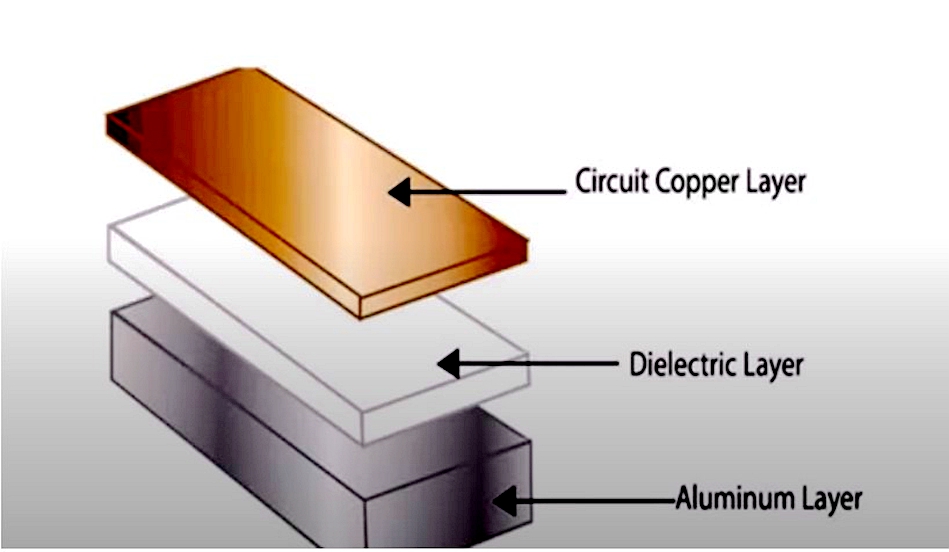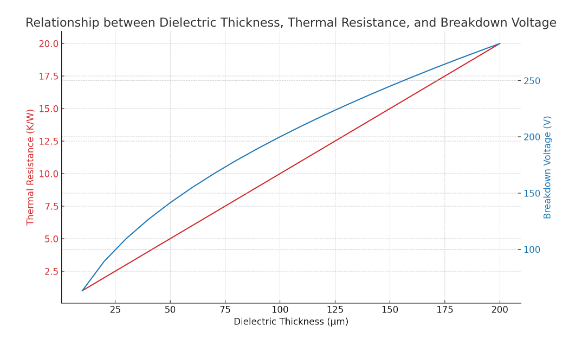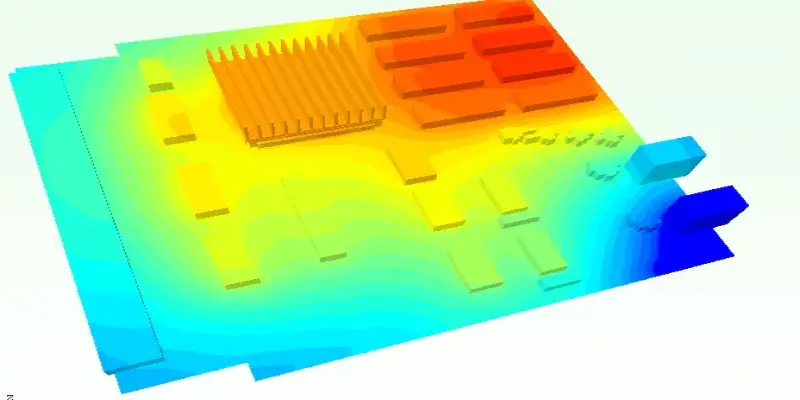Selecting the right dielectric material for aluminum PCBs is crucial for ensuring optimal performance in high-power electronics, thermal management, and signal integrity. Whether you're designing for LED lighting, automotive systems, or power converters, the dielectric layer in an aluminum PCB plays a key role in heat dissipation, electrical insulation, and overall reliability. In this comprehensive guide, we'll walk you through the essential factors to consider when choosing a dielectric material for aluminum PCBs, focusing on high thermal conductivity, low Dk (dielectric constant), and optimal dielectric thickness to enhance performance.
At its core, the best dielectric material for an aluminum PCB balances thermal conductivity, electrical insulation, and compatibility with your specific application. Below, we dive into the details of dielectric material selection for aluminum PCBs, providing actionable insights to help you make informed decisions.
What Is a Dielectric Material in Aluminum PCBs?
Aluminum PCBs, often referred to as metal core PCBs, are widely used in applications requiring excellent heat dissipation, such as LED lighting and power electronics. Unlike traditional FR-4 boards, aluminum PCBs feature a metal base layer, typically aluminum, which acts as a heat sink. Sandwiched between this aluminum base and the copper circuit layer is the dielectric material—an insulating layer that prevents electrical conductivity while facilitating heat transfer.
The dielectric material in an aluminum PCB serves two primary purposes: it electrically isolates the copper traces from the metal base and conducts heat from the components to the aluminum layer for dissipation. Choosing the right dielectric material for aluminum PCBs directly impacts the board's thermal performance, electrical properties, and durability.

Key Factors in Choosing Dielectric Material for Aluminum PCBs
When selecting a dielectric material for aluminum PCBs, several properties must be evaluated to ensure it meets the demands of your application. Let's explore the most critical factors, including thermal conductivity, dielectric constant (Dk), dielectric thickness, and more.
1. High Thermal Conductivity Dielectric for Heat Dissipation
One of the primary reasons for using aluminum PCBs is their superior PCB thermal management capabilities. The dielectric material must efficiently transfer heat from the copper layer to the aluminum base to prevent overheating of components. A high thermal conductivity dielectric is essential for applications like high-power LEDs or motor controllers, where heat buildup can degrade performance or cause failure.
Thermal conductivity is measured in watts per meter-kelvin (W/m·K). Standard dielectric materials may have thermal conductivity values ranging from 0.8 to 1.5 W/m·K, while advanced materials can achieve 2.0 to 3.0 W/m·K or higher. For instance, some specialized dielectrics infused with ceramic fillers can significantly enhance heat transfer, making them ideal for high-power designs.
When choosing a high thermal conductivity dielectric, consider the operating temperature of your application. Materials with higher thermal conductivity often maintain performance at elevated temperatures, ensuring long-term reliability.
Suggested Reading: Solving Heat Issues: How Aluminum PCBs Enhance Automotive Electronics
2. Low Dk Dielectric for Aluminum PCB Signal Integrity
The dielectric constant (Dk) of a material measures its ability to store electrical energy in an electric field. A low Dk dielectric for aluminum PCBs is critical in high-frequency applications where signal integrity and speed are priorities. A lower Dk value reduces signal delay and minimizes crosstalk between traces, which is especially important in RF and communication devices.
Typical Dk values for dielectric materials in aluminum PCBs range from 3.5 to 4.5. However, for high-frequency designs, opting for a low Dk dielectric with values closer to 2.5 or below can improve performance. This ensures faster signal propagation and reduces losses, which is vital for maintaining data integrity in modern electronics.
Balancing a low Dk dielectric with thermal conductivity can be challenging, as materials optimized for one property may compromise the other. Therefore, it's essential to define the primary needs of your project—whether thermal management or signal integrity takes precedence.
3. Dielectric Thickness in Aluminum PCBs: Finding the Sweet Spot
The dielectric thickness in aluminum PCBs directly affects both thermal and electrical performance. A thinner dielectric layer improves heat transfer by reducing the thermal resistance between the copper and aluminum layers. However, it may compromise electrical insulation, increasing the risk of breakdown under high voltages.
Common dielectric thicknesses for aluminum PCBs range from 50 to 150 micrometers (μm). For high-power applications, a thickness of 75-100 μm often provides a good balance between thermal conductivity and insulation. In contrast, thicker dielectrics (120-150 μm) may be necessary for applications requiring higher voltage isolation, though they can hinder heat dissipation.
Optimizing dielectric thickness for aluminum PCBs requires understanding your application's voltage requirements and thermal load. Testing different thicknesses during the prototyping phase can help identify the ideal specification for your design.

4. Breakdown Voltage and Electrical Insulation
The dielectric material must withstand the operating voltage of your application without breaking down. Breakdown voltage, often expressed in volts per mil (V/mil), indicates the maximum voltage a material can handle before failing. For aluminum PCBs used in high-voltage systems, such as power supplies, selecting a dielectric with a high breakdown voltage is non-negotiable.
For example, a dielectric with a breakdown voltage of 3,000 V/mil can handle significant electrical stress, making it suitable for industrial applications. Ensure that the chosen material's breakdown voltage exceeds your system's maximum operating voltage by a safe margin to account for spikes or surges.
5. Chemical and Environmental Stability
Aluminum PCBs are often used in harsh environments, such as automotive or outdoor lighting systems. The dielectric material must resist moisture, chemicals, and temperature fluctuations to prevent degradation over time. Materials with high chemical stability and low moisture absorption are ideal for ensuring long-term reliability.
Look for dielectric materials rated for wide temperature ranges (e.g., -40°C to 150°C) and those with low water absorption rates (less than 0.5%). These properties help maintain electrical and thermal performance even in challenging conditions.
Common Dielectric Materials for Aluminum PCBs
Several dielectric materials are commonly used in aluminum PCBs, each with unique properties suited to specific applications. Below are some popular options to consider when optimizing dielectric performance.
- Epoxy-Based Dielectrics: These are cost-effective and provide decent thermal conductivity (around 1.0-1.5 W/m·K). They are suitable for general-purpose applications but may not excel in high-frequency or extreme temperature environments due to moderate Dk values (around 4.0).
- Ceramic-Filled Dielectrics: Offering higher thermal conductivity (2.0-3.0 W/m·K), these materials are ideal for high-power applications. They often have slightly higher Dk values but provide excellent heat dissipation and stability.
- Polyimide-Based Dielectrics: Known for flexibility and high-temperature resistance, polyimide dielectrics are used in applications requiring durability under thermal stress. Their thermal conductivity is lower, but they excel in harsh environments.
Selecting the right material depends on balancing cost, performance, and environmental requirements. Collaborating with a trusted PCB supplier can help you access advanced dielectric options tailored to your needs.
Tips for Optimizing Dielectric Performance in Aluminum PCBs
Beyond selecting the right dielectric material, optimizing performance requires attention to design and manufacturing details. Here are some practical tips to maximize the efficiency of your aluminum PCB:
- Match Dielectric Properties to Application Needs: Clearly define whether thermal conductivity, low Dk, or insulation strength is the priority for your project. For instance, prioritize high thermal conductivity for LED applications and low Dk for RF circuits.
- Simulate Thermal and Electrical Performance: Use simulation tools to model how different dielectric materials and thicknesses affect heat dissipation and signal integrity. This can save time and cost during prototyping.
- Consider Multilayer Designs: In complex designs, combining multiple dielectric layers with varying properties can address both thermal and electrical requirements effectively.
- Work with Experienced Manufacturers: Partner with a PCB provider that offers customization options for dielectric materials and thicknesses. Their expertise can guide you in selecting the best solution for your design.

Challenges in Dielectric Material Selection for Aluminum PCBs
While choosing a dielectric material for aluminum PCBs, engineers often face trade-offs between competing properties. For example, materials with high thermal conductivity may have higher Dk values, impacting signal integrity. Similarly, thinner dielectrics improve heat transfer but reduce insulation strength. Understanding these trade-offs and testing materials in real-world conditions is key to overcoming these challenges.
Additionally, cost can be a limiting factor. Advanced dielectric materials with superior properties often come at a higher price, which may not be feasible for budget-constrained projects. Striking a balance between performance and affordability is essential for successful design.
Conclusion: Making the Right Choice for Your Aluminum PCB
Choosing the best dielectric material for aluminum PCBs involves evaluating thermal conductivity, dielectric constant, thickness, breakdown voltage, and environmental stability. A high thermal conductivity dielectric ensures efficient heat dissipation, while a low Dk dielectric for aluminum PCBs supports signal integrity in high-frequency applications. Optimizing dielectric thickness and performance requires aligning material properties with your specific design needs.
By carefully considering these factors and leveraging simulation tools and manufacturer expertise, you can select a dielectric material that enhances the reliability and efficiency of your aluminum PCB. Whether you're working on LED lighting, power electronics, or automotive systems, the right dielectric material can make all the difference in achieving superior performance.
At ALLPCB, we’re committed to supporting your design journey with high-quality materials and customized solutions. Explore our range of aluminum PCB options and expert guidance to bring your projects to life with confidence.
 ALLPCB
ALLPCB







